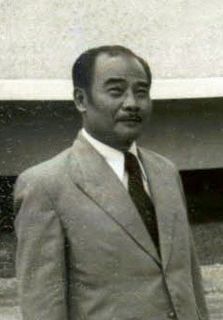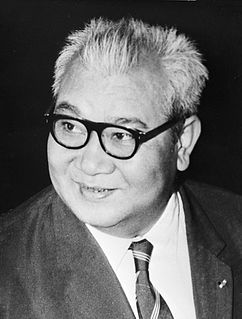Related Research Articles
Evidence for modern human presence in the northern and central highlands of Indochina, that constitute the territories of the modern Laotian nation-state dates back to the Lower Paleolithic. These earliest human migrants are Australo-Melanesians — associated with the Hoabinhian culture and have populated the highlands and the interior, less accessible regions of Laos and all of South-east Asia to this day. The subsequent Austroasiatic and Austronesian marine migration waves affected landlocked Laos only marginally and direct Chinese and Indian cultural contact had a greater impact on the country.

Việt Minh was a national independence coalition formed at Pác Bó by Hồ Chí Minh on May 19, 1941. The Việt Nam Độc Lập Đồng Minh Hội had previously formed in Nanjing, China, at some point between August 1935 and early 1936 when Vietnamese nationalist parties formed an anti-imperialist united front. This organization soon lapsed into inactivity, only to be revived by the Indochinese Communist Party (ICP) and Hồ Chí Minh in 1941. The Việt Minh established itself as the only organized anti-French and anti-Japanese resistance group. The Việt Minh initially formed to seek independence for Vietnam from the French Empire. The United States supported France. When the Japanese occupation began, the Việt Minh opposed Japan with support from the United States and the Republic of China. After World War II, the Việt Minh opposed the re-occupation of Vietnam by France, resulting in the Indochina War, and later opposed South Vietnam and the United States in the Vietnam War. The political leader and founder of Việt Minh was Hồ Chí Minh. The military leadership was under the command of Võ Nguyên Giáp. Other founders were Lê Duẩn and Phạm Văn Đồng.

Kaysone Phomvihane was the first leader of the Communist Lao People's Revolutionary Party from 1955 until his death in 1992. After the Communists seized power in the wake of the Laotian Civil War, he was the de facto leader of Laos from 1975 until his death. He served as the first Prime Minister of the Lao People's Democratic Republic from 1975 to 1991 and then as the second President from 1991 to 1992.

Prince Souphanouvong was, along with his half-brother Prince Souvanna Phouma and Prince Boun Oum of Champasak, one of the "Three Princes" who represented respectively the communist (pro-Vietnam), neutralist and royalist political factions in Laos. He was the figurehead President of Laos from December 1975 to August 1991.

Prince Boun Oum was the son of King Ratsadanay, and was the hereditary prince of Champassak and also Prime Minister of the Kingdom of Laos from March 1949 to February 1950 and again from December 1960 to June 1962.

Prince Phetsarath Ratanavongsa (Somdej Chao Maha Uparaja Petsaraj Ratanavongsa was the 1st Prime Minister of Luang Phrabang in French Laos from 21 August 1941 to 10 October 1945, and Head of State of Laos between 12 October 1945 and 4 April 1946.

Prince Souvanna Phouma was the leader of the neutralist faction and Prime Minister of the Kingdom of Laos several times.

Phoumi Vongvichit was a leading figure of the Pathet Lao and an elder statesman of the Lao People's Democratic Republic.

The Laotian Civil War (1959–1975) was a civil war in Laos which was waged between the Communist Pathet Lao and the Royal Lao Government from 23 May 1959 to 2 December 1975. It is associated with the Cambodian Civil War and the Vietnam War, with both sides receiving heavy external support in a proxy war between the global Cold War superpowers. It is called the Secret War among the CIA Special Activities Center and Hmong veterans of the conflict.

Ramon del Fierro Magsaysay Sr. was a Filipino statesman who served as the seventh president of the Philippines, from December 30, 1953, until his death in an aircraft disaster. An automobile mechanic by profession, Magsaysay was appointed military governor of Zambales after his outstanding service as a guerrilla leader during the Pacific War. He then served two terms as Liberal Party congressman for Zambales's at-large district before being appointed Secretary of National Defense by President Elpidio Quirino. He was elected president under the banner of the Nacionalista Party. He was the first Philippine president born in the 20th century and the first to be born after the Spanish colonial era.

The flag of Laos consists of three horizontal stripes, with the middle stripe in blue being twice the height of the top and bottom red stripes. In the middle is a white disc, the diameter of the disc is 4⁄5 the height of the blue stripe. The flag ratio is 2:3.
This article details the history of Laos since 1945.

The French protectorate of Laos was a French protectorate in Southeast Asia of what is today Laos between 1893 and 1953—with a brief interregnum as a Japanese puppet state in 1945—which constituted part of French Indochina. It was established over the Siamese vassal, the Kingdom of Luang Phrabang, following the Franco-Siamese War in 1893. It was integrated into French Indochina and in the following years further Siamese vassals, the Principality of Phuan and Kingdom of Champasak, were annexed into it in 1899 and 1904, respectively.

The Lao Issara was an anti-French, non-communist nationalist movement formed on 12 October 1945 by Prince Phetsarath. This short-lived movement emerged after the Japanese defeat in World War II and became the government of Laos before the return of the French. It aimed to prevent the French from restoring their control over Laos. The group disbanded in 1949.
Healthcare in Laos is provided by both the private and public sector. It is limited in comparison with other countries. Western medical care is available in some locations, but remote areas and ethnic groups are underserved. Public spending on healthcare is low compared with neighbouring countries. Still, progress has been made since Laos joined the World Health Organization in 1950: life expectancy at birth rose to 66 years by 2015; malaria deaths and tuberculosis prevalence have plunged; and the maternal mortality ratio (MMR) has declined by 75 percent.

Norodom Arunrasmy is a Cambodian princess, politician, and diplomat. She is the youngest daughter of HM King Father Norodom Sihanouk and stepdaughter of Queen Mother Norodom Monineath. Her birth mother is Mam Manivan Phanivong, a Lao woman who was born in Vientiane, Laos and married King Sihanouk in 1949.

Sombath Somphone is an internationally acclaimed community development worker and prominent member of Lao civil society. Sombath was abducted from a Vientiane street in 2012 and has not been seen since.
Phaya Khammao Vilay was a Lao politician. He was born in Luang Prabang, and was educated in France, and eventually in 1917 joined the French colonial administrator in Laos. He was appointed as governor of Viang Chan from 1941 to 1945. He was one of the big contributors for funding Lao Issara in the cause of fighting for independent from France.
General Sing Rattanasamay (1912–1973) was one of the officers who founded the Royal Lao Army (RLA). Originally a policeman, he joined the anti-Japanese resistance during World War II, and the anti-French Lao Issara from 1946–1949. He subsequently joined the nascent RLA, and went on to serve the Kingdom of Laos until just prior to his death in 1973.
Khampheng Boupha is a Laotian former politician, who served as a member of the Central Committee of the Lao People's Revolutionary Party and President of the Lao Women's Union.
References
- 1 2 3 4 5 Balgos, Cecile C.A., ed. (2007). "Keo Viphakone". Great Men and Women of Asia: Ramon Magsaysay Awardees from Southeast Asia 1958-1973. Anvil.
- 1 2 "Viphakone, Keo: BIOGRAPHY". Ramon Magsaysay Award Foundation. Retrieved 21 September 2015.
- ↑ "Keo Viphakone Seeks Asylum". The Indiana Gazette. 17 March 1977. Retrieved 21 September 2015.